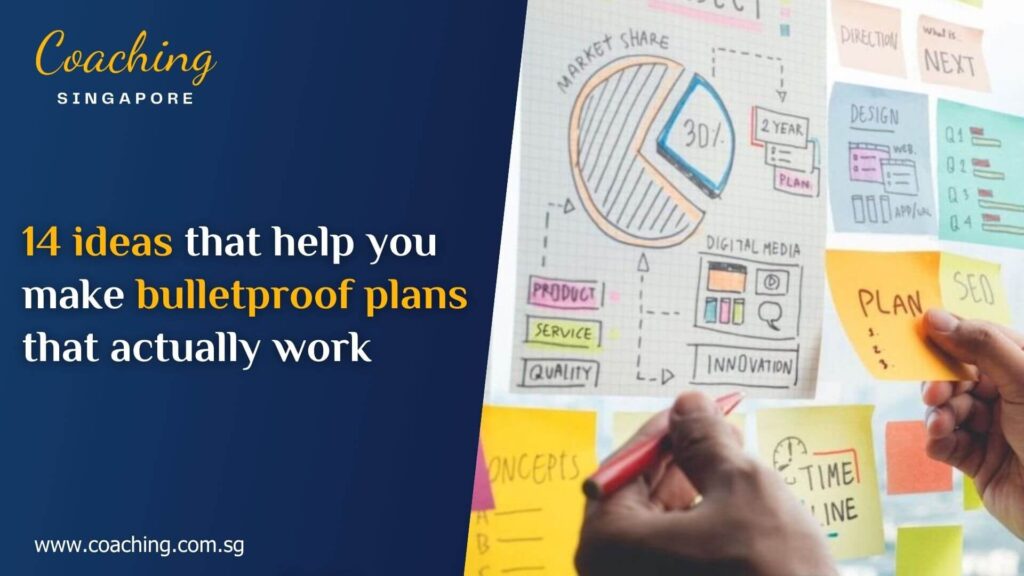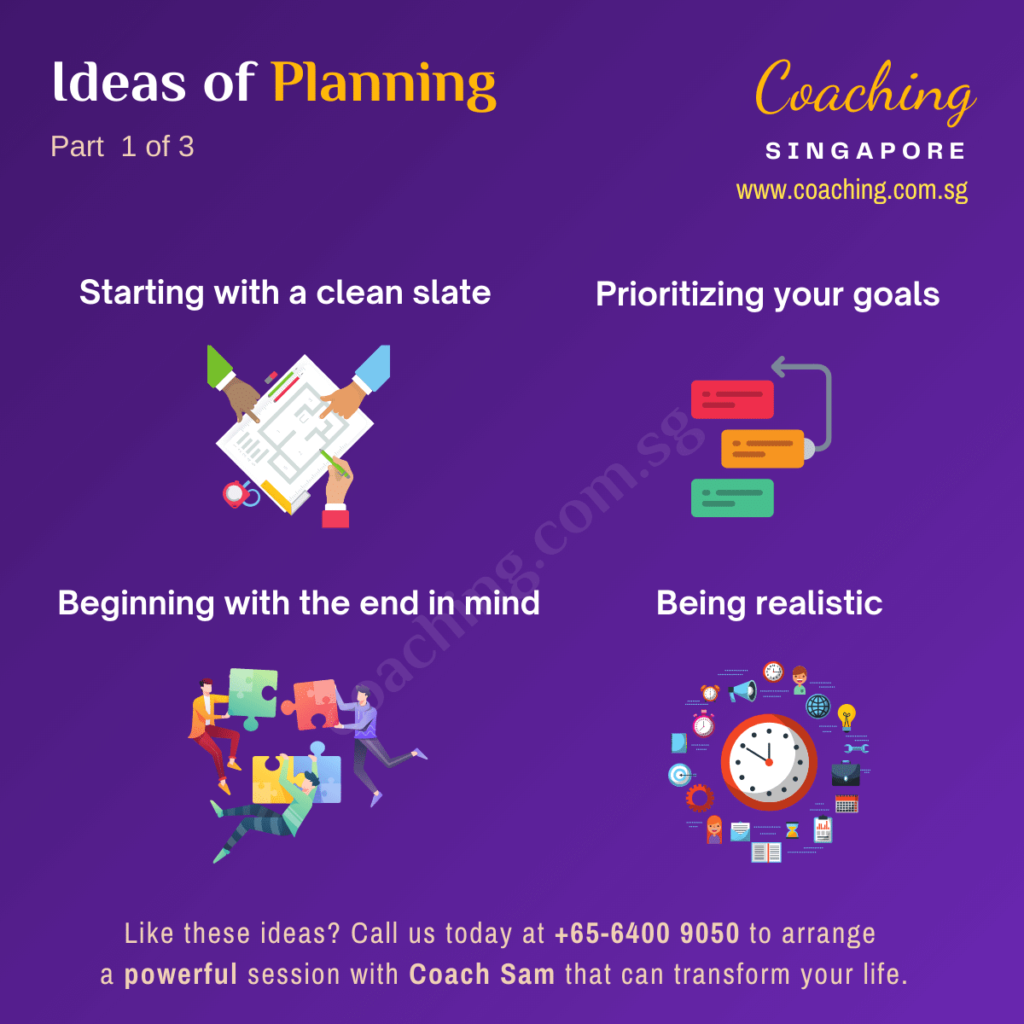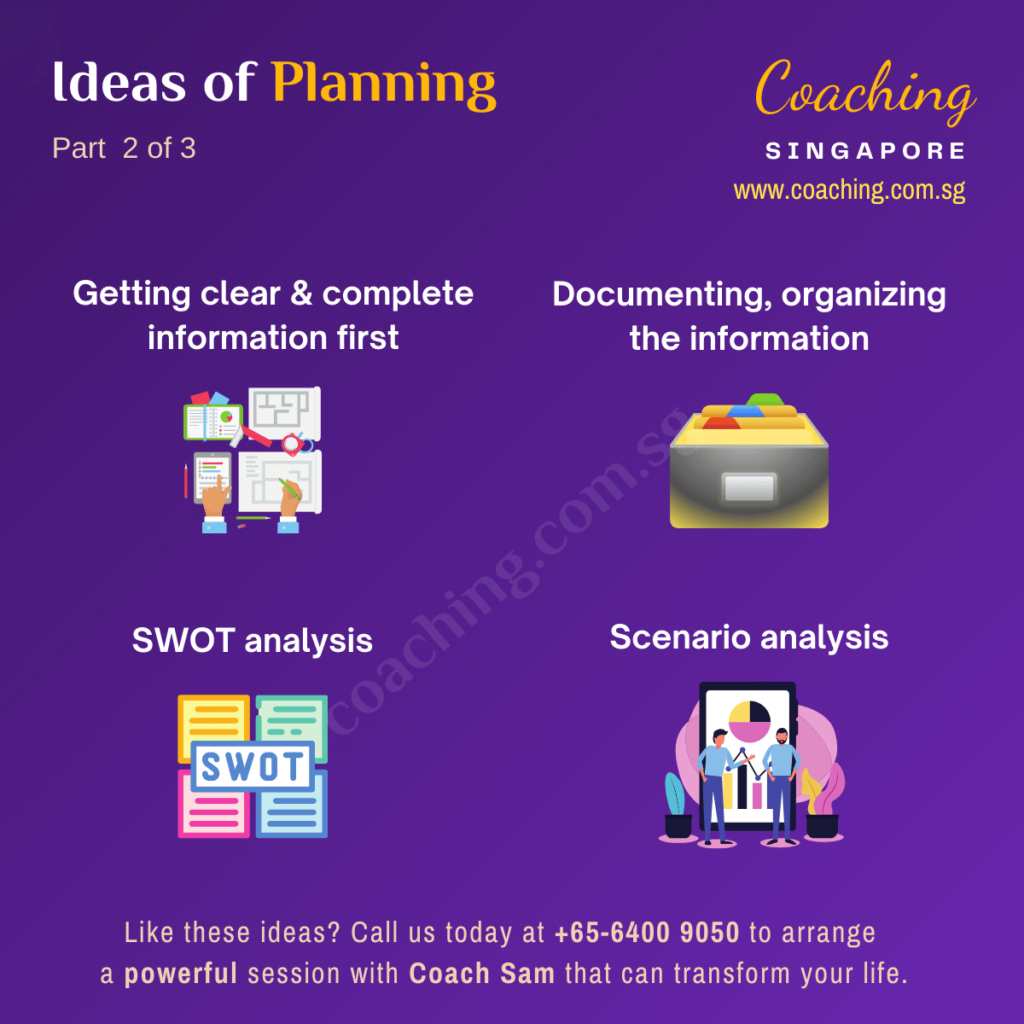Home » Mental Resilience » 14 ideas that help you make bulletproof plans that actually work
14 ideas that help you make bulletproof plans that actually work

- Author: Coach Sam
From designing…
- a software development project workflow,
- to a family’s personal finances,
- to a marketing campaign for a new product,
- or vacation in a faraway land so as to savor all of its best experiences in a short span of time,
… to get anything done right in today’s world, we often need to navigate various factors.
We need to weigh the pros and cons of the choices that add up to success.
For that purpose, we need to harness a skill set that is vital.
It entails us setting aside most of our cognitive biases and training ourselves for logical, rational thinking.
We need to apply lessons from hindsight and make sound assumptions about the future (also known as projections and foresight).
This skill of making well-thought-through choices and arranging things in advance is known as planning.
It is the process of forming a list of sequential actions from start to completion.
As they say, for success – “you need to plan your work and work your plan” and “those who don’t plan, plan to fail”.
In this article, I have explained a few ideas that will help you eventually become a masterful planner.
Idea #1 - Starting with a clean slate
We need to start to have an open mind first, to dig out, absorb, understand and organize all the relevant information.
This needs us to be in a state that masters of meditation advocate – objective, alert, equanimous, and unbiased.
Only then can we begin on the right footing.
Idea #2 - “Plans are nothing, planning is everything”
The above is a famous phrase attributed to Dwight D. Eisenhower, World War Two general and later US president, about the difference between “Plans” and “Planning”.
The actual quotation is: “In preparing for battle I have always found that plans are useless, but planning is indispensable.”
A mental exercise:
Some questions that we can ponder upon…
- Why is planning “everything”, i.e. indispensable?
- What is the relationship between plans and planning?
- Why is the act of planning often more vital than plans made in the past?
- Can we apply this expression in today’s business, careers, and even our own lives?
The reason why the act of planning regularly is vital is that, when we plan, we keep taking into account newly-arisen factors to adjust both the process (journey) and the goal (destination) if need be while still holding on to the unchanging, overarching principles.
This gives us the peace of mind that the plan we are working with to invest our precious resources is up-to-date and as intelligent as can be.
Not doing this would mean in effect being foolishly blind to reality as it is.
Of course, randomly over-planning has its own disadvantages and must be avoided.
Idea #3 - Beginning with the end in mind
Beginning with the end in mind is all about asking yourself questions to determine your objectives and the reasons behind wanting to achieve them:
- What exactly is the end goal of what I’m trying to achieve?
- Why is that end goal so valuable to me?
- What am I happy to sacrifice for that end goal?
- What am I not willing to sacrifice for this particular goal?
Answering these questions is the absolute foundation of ‘beginning with the end in mind’.
It’s also about fast-forwarding into the future and considering what it looks like for you.
People are typically motivated by hopes and aspirations, so knowing what you want in your future to be can be a strong source of motivation.
Idea #4 - Prioritizing your goals
Prioritizing work is likely the most vital skill for anyone to achieve success – from the line worker to the boss of the company to homemakers to students.
This is because most of us today need to juggle with more than one deliverable.
To effectively prioritize your projects, you need to identify how urgent and how important all your different work tasks are, and rank them accordingly.
Important work should align with your long-term goals and mission, whereas urgent work simply needs to be done as soon as possible.
By learning proper prioritization techniques, you’ll become more productive in your work life and more focused on your goals.

Idea #5 - Being realistic
Good plans are based on sound principles.
Principles are time-tested lessons that rarely change.
The goal of the plans should be based on available resources and existing constraints.
Some stories and movies fill us with ideas that we should “aim for the moon and the stars”.
Those aims are fine if they are backed up by logic and facts.
This does not mean one needs to be over-conservative, too cautious, pessimistic, or following tradition blindly.
It is a good idea to pause, look up, and around to see if factors have changed to help us achieve what was impossible yesterday.
We must not be tied down or burdened by past lessons alone.
An example is when a domesticated elephant is young, it is tied to a tree by a chain.
It learns quickly that it cannot break free.
Now, even when it grows up to be big and strong, its owner often uses a simple coir rope to tie it.
The elephant, assuming it still can’t break free, never even tries.
History is a great teacher, but can’t be the only guide.
Idea #6 - Getting clear and complete information first
We need a full picture of the present and future factors – assets that help us and liabilities that we have to prepare to settle.
Let us consider an organization in order to illustrate this point.
In order to determine the direction & success of an organization, it is necessary to understand its current position and the possible avenues through which it can pursue a particular course of action.
We need to have a bird’ eye view of the present & future factors of your plan.
This holds true at an individual as well as on an organizational level.
Idea #7 - Documenting, organizing the information
The objective of documenting i.e. noting down all the relevant information in a clear format is to organize it.
Organizing the data is to…
- categorize this collated knowledge,
- tag if for easy retrieval later,
- and sequence them out for processing into something more meaningful.
This process is pivotal in the next logical step of planning.
Idea #8 - SWOT analysis
SWOT stands for Strengths, Weaknesses, Opportunities, Threats.
SWOT analysis is a planning methodology that helps organizations build a strategic plan to meet goals, improve operations and keep the business relevant.
During SWOT analysis, organizations identify factors that affect short- and long-term growth, products and services, business objectives, and market competition.
You can apply this strategy in building your individual as well as company plans.

Idea #9 - Scenario Analysis
It is vital to simulate “stress tests”.
By that, I mean looking at all the possibilities, sorted by the associated costs and the likelihood of occurring.
Only when our plan has the resilience to withstand at least a few different situations that might happen, can we feel assured that the plan is robust.
An example of this, when doing personal financial planning, is factoring in accidents, illnesses, job loss of a breadwinner, stock market crashes, and the like.
In an organization, a financial forecast is an estimate of future financial outcomes for a company.
This needs several assumptions about the future to be deployed.
Using historical internal accounting and sales data, in addition to external market and economic indicators, a financial forecast is an economist’s best guess of what will happen to a company in financial terms over a given time period.
This period could be several months to several years.
Multiple stakeholders’ assumptions and vision of the future are used to estimate growth rates and potential events that affect key numbers on a financial statement going forward.
Idea #10 - Uncovering the “gaps”
We often find there are key elements and areas that need to be fixed in our current situation for them to match what our plans need to reach our intended targets.
These missing aspects are the “gaps” that we have uncovered and must resolve.
Gap analysis can also help you compare your business or personal project’s actual performance against the performance you planned for.
This way you can figure out what actually worked for you and what didn’t, and why.
More importantly, this process allows you to clearly think about the relevant solutions for your planning gaps & how to go about fulfilling them.
Idea #11 - Figuring out waste, and ways to reduce it
All plans will have some parts that you will discover post-execution which are not serving the actual objective of why the plan was made in the first place.
That’s completely normal as that is a part of the process, so learn to actively find out those areas of wastage or where things are not working adequately, and eliminate them efficiently in order to ensure the accomplishment of the objective of the plan.
Idea #12 - The ultimate aim is the action plan
You can have the best plan & planning process in the world, however, it won’t work if you won’t work for it as needed.
Ideation without execution is a delusion.
The simplest process of planning is identifying gaps and ways to fill them – sequentially.
This may need us to act alone, but more commonly, with the help of others – people and systems.
Once we have ordered the things we need to do based on priority, along with the tools and resources we need to take that step, our action plan is ready.
The best action plans are so well made, they are “no-brainers” and require the least amount of effort for maximum effect.
So ensure you have your well-crafted action plan ready, and then go ahead to execute it.

Idea #13 - Tracking results meticulously
Results are feedback.
It is only when we note what happens when we change our behavior or input that we start to learn how the real world responds.
This learning is an eye-opener as well as a calibration tool – are we doing too little or too much.
We can use it to investigate the causes of the changes – such as factors that we may not have considered in our earlier planning.
And it is a motivator for us to keep going.
A great example of this when we are looking to transform our bodies like building more muscle or losing fat.
We track our meals, timings, sleep, weight, and body fat percentages.
Good trainers and nutritionists also suggest keeping score of qualitative factors like our energy levels and moods.
Idea #14 - Reviewing the plan regularly
Over time, many of the factors we considered during our initial planning change.
These can include our goals, assets, and contingencies.
We also learn from the results of our earlier plan implementation, which may need us to “course correct”.
It is due to this reason that we must get back to the drawing board regularly with a qualified planner. Often, just minor updates are needed to the overall plan, but at times, a blueprint has to be redone.
What is vital is to not change the plan willy-nilly, for less than the very best of reasons.
An example of the above is: when a good stock market investment plan has been agreed upon, it is even more crucial to stick to it and stay invested when markets are down, rather than sell and run in a panic.
That is why good plans are based on a foundation of good principles that are often timeless.
Comment: Is there any strategy that you personally used & benefited from to make plans that work which was not covered in this blog?
Then please let me know in the comment section below, I would love to learn from you & hear your stories.
Share This Post, Choose Your Platform!
